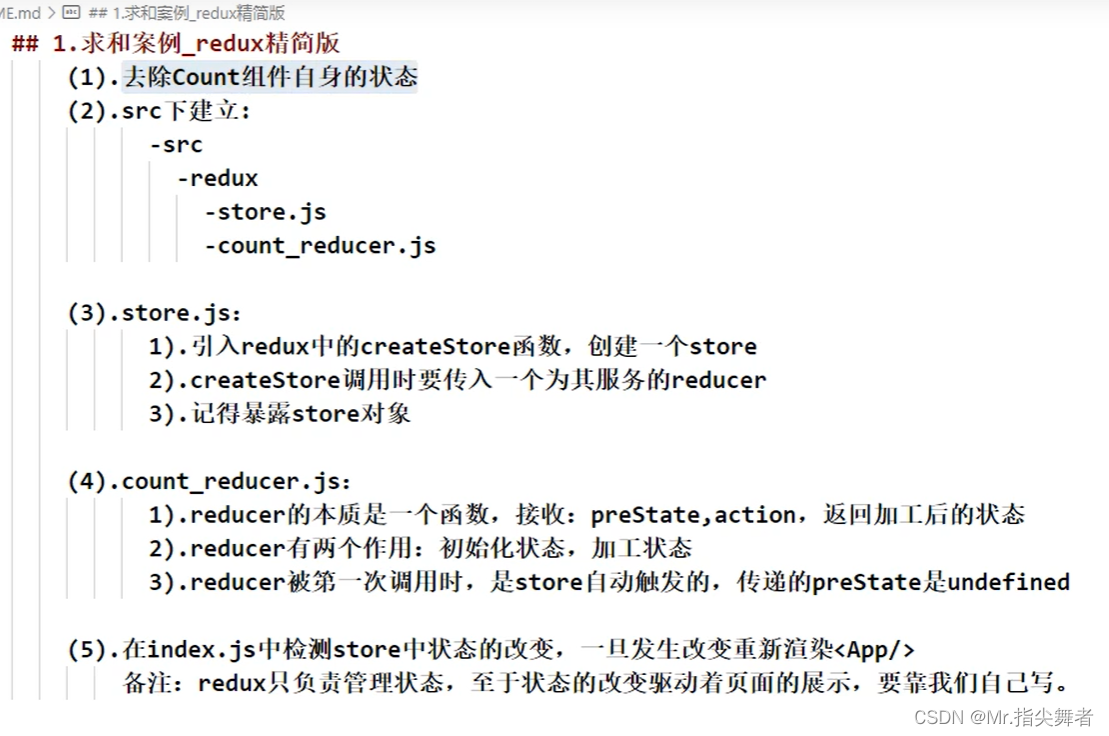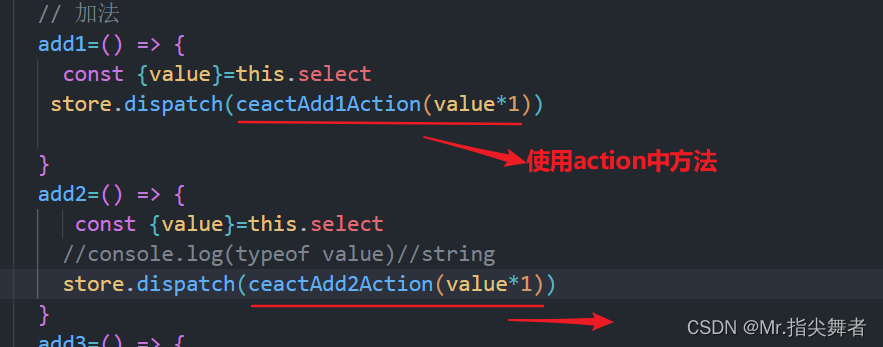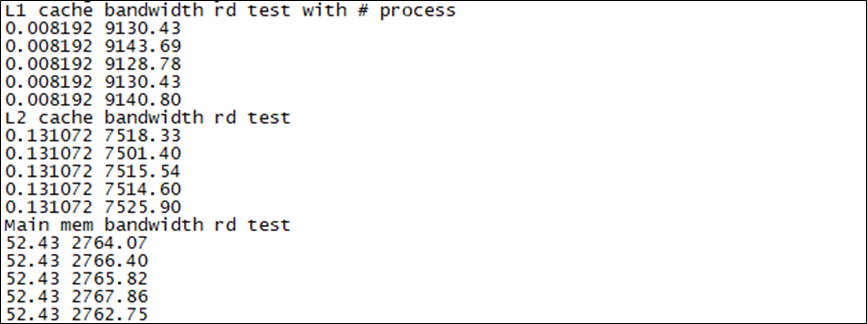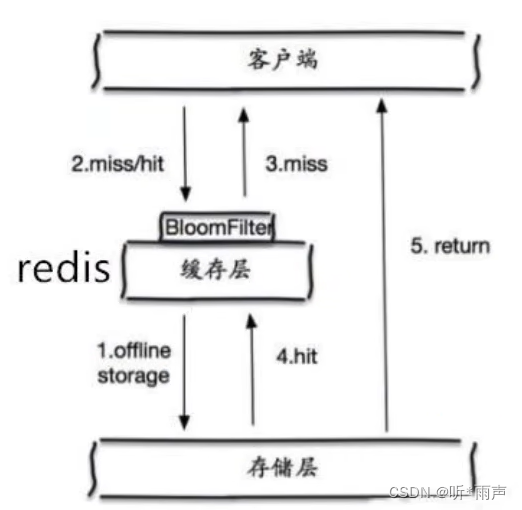当前位置:网站首页>Redux - detailed explanation
Redux - detailed explanation
2022-07-02 15:32:00 【Mr. fingertip dancer】
One . First time to know Redux
amount to vue Medium vuex
1.redux It is an independent and specialized tool for state management JS library ( No react Plug-in library )
2. It can be used in react, angular, vue Etc , But it's basically the same as react In combination with
3. effect : Centralized management react The state shared by multiple components in the application
have a look Redux Working schematic diagram
If you want to do Add one The operation process is as follows :
It is worth noting that :Reducers Not only Processing status available , You can also initialize the state (undefinded)

Two , The core concept
Store
stay redux Inside , only one Store, The data that the whole application needs to manage is in this Store Inside . This Store We can't change it directly , We can only return a new Store To change it .redux Provides a createStore To create state
import { createStore } from 'redux'
const store = createStore(reducer)action
This action It refers to an operation initiated by the view layer , tell Store We need to change . For example, the user clicks the button , We are going to request the list , The data of the list will change . Every action There has to be one type attribute , This means action The name of , then There can be one more payload attribute , This attribute can take some parameters , Used as a Store change :
const action = {
type: 'ADD_ITEM',
payload: 'new item', // Optional attribute
} The above example defines a named ADD_ITEM Of Action, It also carries a payload Parameters of . Redux It can be used Action Creator Batch to generate some Action.
Reducer
Above we define a Action, however Action Will not automatically send out the change operation to Store, So here we need one called dispatch Things that are , It is specially used to send action, But also good , This dispatch We don't need to define and implement ourselves ,redux It has been written for us , stay redux Inside ,store.dispatch() yes View issue Action The only way .
store.dispatch({
type: 'ADD_ITEM',
payload: 'new item', // Optional attribute
}) When dispatch Launched a action after , Will arrive reducer, So this reducer What do you use it for ? seeing the name of a thing one thinks of its function , This reducer Is used to calculate the new store Of ,reducer Receive two parameters : Current state And received action, Then it is calculated , Will return a new state.( As we have said before , You can't change it directly state, You must return a new state To make changes .)
const reducer = function(prevState, action) {
...
return newState;
}; This reducer It's a pure function . Pure function means , For the same input , There will only be the same output , Does not affect external values , It will not be affected by external values . Pure function belongs to the concept of functional programming , If you want to know more about the concept of pure functions , Please have a look at here
You can see , We're creating store When , We are createStore There is a reducer Parameters , ad locum , We just want to , Every time store.dispatch Send a new action,redux Will automatically call reducer, Return to new state.
Here's an example
Implement a computing function


1. So let's create one Redux Folder , Create separate store.js and reducers.js file
store.js in
// introduce creacteStore, Dedicated to creating redux The core of store object
import { legacy_createStore as createStore } from "redux";
// Introduced as Count Component services reducer
import countRedux from './reducers'
const store=createStore(countRedux)
// Expose
export default storereducers.js In file
This code refers to the schematic diagram above
// Receive two parameters The state before preState, And action objects action
//const init=0
export default function countRedux(preState,action) {
// from action Object :type,data
console.log(preState,action);
const {type,data}=action
// According to what was passed in type Determine what to do
switch (type) {
// If the type is plus , Use the value before transmission +action The value in , Back out
case 'add1':
return preState+data
case 'add2':
return preState-data
default:
// Return initialization data
return 0
}
}stay count.js in
store.getState() obtain reducx Return value in
store.dispatch() towards redux Sent in The value before the first parameter The second parameter is action object
store.subscribe() When Redux When the state changes , Force update rendar, Let the page render
import React, { Component } from 'react';
// Introduce state
import store from './redux/store.js'
class count extends Component {
state={
}
// Called when a component is mounted
componentDidMount(){
// When Redux When the state changes , Force update rendar, Let the page render
store.subscribe(() => {
this.setState({})
})
}
// Add
add1=() => {
const {value}=this.select
store.dispatch({type:'add1',data:value*1})
}
add2=() => {
const {value}=this.select
//console.log(typeof value)//string
store.dispatch({type:'add2',data:value*1})
}
add3=() => {
const {value}=this.select
//console.log(typeof value)//string
const count=store.getState()
//string+number=string So we need to string turn number
if(count%2!==0) {
store.dispatch({type:'add1',data:value*1})
}else{
alert(' Does not meet the odd number requirement ')
}
}
add4=() => {
const {value}=this.select
//console.log(typeof value)//string
//string+number=string So we need to string turn number
setInterval(()=>{
store.dispatch({type:'add1',data:value*1})
},2000)
}
render() {
return (
<div>
{/* To obtain state */}
<h4>{store.getState()}</h4>
<select ref={(c)=>{this.select=c}}>
<option value='1'>1</option>
<option value='2'>2</option>
<option value='3'>3</option>
<option value='4'>4</option>
</select>
<button onClick={this.add1}>+</button>
<button onClick={this.add2}>-</button>
<button onClick={this.add3}> The current sum is odd plus </button>
<button onClick={this.add4}> Asynchronous add </button>
</div>
);
}
}
export default count;The forced update in the life cycle hook in the above code can be optimized
stay index.js Set in the entry file

The above method is abbreviated , Now we're going to transform
Observe the schematic diagram , We ignored the one above action, Let's create action.js file
action.js
Here you can add and subtract
/**
* Specially for Count Component generation action object
*/
// Add Abbreviated mode of arrow function
export const ceactAdd1Action=data=>({type:'add1',data:data})
// Subtraction Normal mode
export function ceactAdd2Action(data){
return {type:'add2',data:data}
}stay count.js Modify in process
Import first
import {ceactAdd1Action,ceactAdd2Action} from './redux/action.js'Modify the code
The addition of odd numbers is omitted here , And asynchronous addition

3、 ... and . asynchronous action
1. What is asynchronous action?
With asynchrony action, There must be synchronization action. General situation We put the object (Object) The form is called synchronization action
function (function) The form is called asynchronous action , Our example above action What is passed in is an object , He is synchronized
for instance :
If you go to the canteen for dinner ,1. You wait 5min Say serve to the waiter ( This is how the above example implements asynchrony )
2. You tell the waiter to serve in five minutes ,( This is asynchronous action)
2. When to use ?
When you make it clear that you don't want to give the delayed task to your own components , I want to give it to you action when
3. How to use it? ?
Install middleware Configure in store in
yarn add redux-thunkstay store.js Middle configuration

stay count.js in
add4=() => {
const {value}=this.select
//console.log(typeof value)//string
//string+number=string So we need to string turn number
store.dispatch(ceactAsyncAdd1Action(value*1,500))
}stay action.js in
Returns a function
export const ceactAsyncAdd1Action=(data,time)=>{
// The return function is asynchronous action
return () => {
setTimeout(() => {
store.dispatch(ceactAdd1Action(data))
},time)
}
}Four .react-rudex

We will continue to add .........
边栏推荐
- LeetCode_ Sliding window_ Medium_ 395. Longest substring with at least k repeated characters
- MD5 encryption
- 百变大7座,五菱佳辰产品力出众,人性化大空间,关键价格真香
- Let your HMI have more advantages. Fet-g2ld-c core board is a good choice
- Bing.com網站
- 面对“缺芯”挑战,飞凌如何为客户产能提供稳定强大的保障?
- 03.golang初步使用
- vChain: Enabling Verifiable Boolean Range Queries over Blockchain Databases(sigmod‘2019)
- MySQL calculate n-day retention rate
- LeetCode刷题——递增的三元子序列#334#Medium
猜你喜欢

I made an istio workshop. This is the first introduction

07_哈希

基于RZ/G2L | OK-G2LD-C开发板存储读写速度与网络实测

21_ Redis_ Analysis of redis cache penetration and avalanche

Solution of Queen n problem

Be a good gatekeeper on the road of anti epidemic -- infrared thermal imaging temperature detection system based on rk3568

终于搞懂了JS中的事件循环,同步/异步,微任务/宏任务,运行机制(附笔试题)

16_ Redis_ Redis persistence

08_ 串

Leetcode skimming -- sum of two integers 371 medium
随机推荐
04. Some thoughts on enterprise application construction after entering cloud native
Facing the challenge of "lack of core", how can Feiling provide a stable and strong guarantee for customers' production capacity?
06_ Stack and queue conversion
19_Redis_宕机后手动配置主机
MySQL -- Index Optimization -- order by
. Net again! Happy 20th birthday
TiDB混合部署拓扑
03_ Linear table_ Linked list
Engineer evaluation | rk3568 development board hands-on test
自定义异常
Bing. Site Internet
Case introduction and problem analysis of microservice
Equipped with Ti am62x processor, Feiling fet6254-c core board is launched!
怎样从微信返回的json字符串中截取某个key的值?
密码学基础知识
基于RZ/G2L | OK-G2LD-C开发板存储读写速度与网络实测
LeetCode_ Sliding window_ Medium_ 395. Longest substring with at least k repeated characters
语义分割学习笔记(一)
损失函数与正负样本分配:YOLO系列
17_Redis_Redis发布订阅
